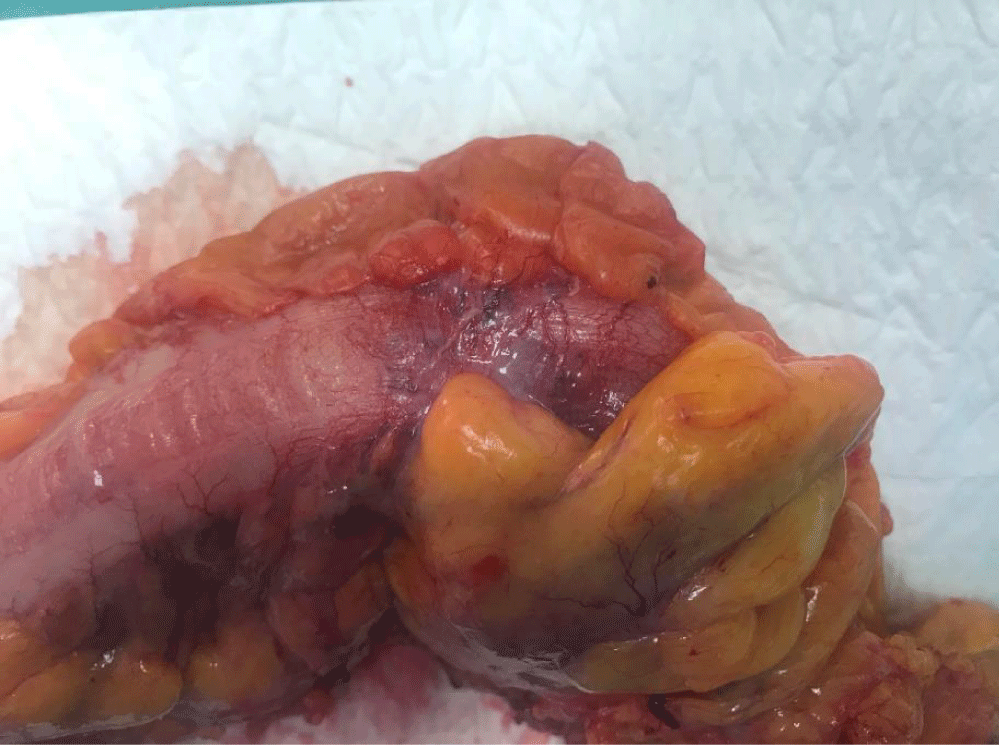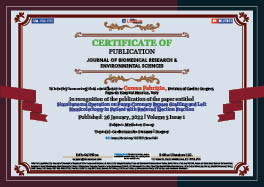Medicine Group . 2022 January 26;3(1):085-087. doi: 10.37871/jbres1404.
Simultaneous Operation on Pump Coronary Bypass Grafting and Left Hemicolectomy in Patient with Reduced Ejection Fraction
Mammana Liboro Francesco, Ceresa Fabrizio*, Rubino Antonino Salvatore, De Donno Filomena Bruna and Francesco Patane
Abstract
This is written so as to report the case of a 75-year-old male with a diagnosis of sigmoid adenocarcinoma accompanied by critical coronary artery disease and angina, which was subject to simultaneous surgical treatment. Was performed first an on – pump coronary artery revascularization and then a left colectomy. Our case suggests that performing an on-pump bypass in patient also with reduced ejection fraction procedure prior to cancer surgery can be a safe surgical in appropriately selected cases.
Introduction
The prevalence of cardiovascular disease and malignant disease has been increasing since the average lifespan has especially lengthened in the developed countries [1]. In general, patients with both cardiovascular disease that requires surgery and a surgically respectable malignancy are treated in a staged procedure depending on the clinical priority. However, a simultaneous approach would be attractive for such patients, because limiting them to a single exposure to anaesthesia and one recovery period remove the potential opportunity for perioperative cardiovascular events, and moreover provide economic benefits. The recent advances in anaesthesia, surgical techniques and perioperative management have allowed for combined operations to be conducted, so several studies have validated the concept that a simultaneous operation can be safely performed in a limited population of patients. We have to consider that when both pathologies are acute, sometimes there is not adequate time to spend on deciding which disease calls for more immediate action. In general, we place priority upon coronary revascularization to oncologic procedure for it is more life-threatening. We are describing the simultaneous surgical procedure of a patient with left colon cancer combined with severe coronary artery disease.
Case Report
A 75-year-old man was admitted to our hospital for a severe anaemia. His past medical history revealed diabetes complicated by retinopathy, hypertension and dyslipidemia.
The patient underwent an Electrocardiogram (EKG) for the new onset of angina: EKG showed in a signs of myocardial ischemia of the anterior and lateral walls accompanied by an elevation of myocardial enzymes (CK - MB = 2.4 U/L, Troponin = 2.46 ng/mL, Hct: 27%)
Afterwards, the coronary angiography was performed and it showed the critical stenosis of Left Anterior Descending Artery (LAD), some branches of circumflex artery and the rigth posterior descending artery. The echocardiogram showed a reduced ejection fraction (40%) with left ventricular apical akinesia.
The recent loss of weight and the persistent severe anaemia despite of the blood transfusions suggested that you performed gastroscopy and colonscopy that revealed the presence of a voluminous neoplasia of the left colon (Figures 1,2).
Heart Team discussed this case and considered it not suitable for the percutaneous intervention for the high risk of peri-procedural intestinal bleeding due to dual antiplatelets therapy. After ruling out the presence of metastasis with a total body Computed Tomography (CT), patient was scheduled for a combined surgery. After harvesting arterial and venous conduits, four coronary artery bypass grafts were performed on Cardiopulmonary Bypass (CPB) Sternotomy was closed and dressed very accurately in order to avoid infective complications like mediastinitis. Consecutively we subtracted via a subumbilical incision the diseased colon by a lower anterior recto-sigmoidal resection. He was admitted to the intensive care unit with low inotropic support. He was transferred to a ward the following day and was discharged, on the 7th postoperative day after an uneventful course (Figure 3).
Discussion
Currently, there are no guidelines, about the correct treatment of this double pathology. Komokata and colleagues described a series of 14 consecutive patients suffering from cardiac disease and gastro-intestinal malignancy: 3 of them underwent simultaneous cardiac and abdominal operation while in the other patients they were performed the surgery in two different stages: clinical results didn't show any differences in both group in term of infective complications [1]. The treatment of patients who require surgery for both cardiac disease and gastrointestinal malignancy is still controversial. Simultaneous active intestinal bleeding and acute heart ischemia create a troublesome environment about patient's surgical approach. A staged procedure depending on the clinical priority is usually preferred because most surgeons assume that the prolonged operative time and extensive surgical invasiveness associated with simultaneous procedures must increase the surgical morbidity and mortalit. However, there are also several unfavorable issues associated with a staged procedure. For instance, when an isolated cardiac operation is performed before gastrointestinal resection, the malignant lesion may develop massive gastrointestinal bleeding due to the heparinization required for CPB, and moreover untreated cancer may progress during the interval prior to the second operation. The concomitant approach, could resolve those problem [2-9]. The international bibliography most of the simultaneous procedures in the present series were performed successfully in short-term period. Most cardiovascular surgeons have concern that the addition of clean-contaminated operation to cardiac operation would increase the incidence of postoperative infection as wound infection, mediastinitis and mechanical valve infection. Nevertheless, Komokata and colleagues didn't show an increased post-operative infecttive complications rate in your series of simultaneous operation for cardiac disease and gastrointestinal malignancy [1].
Conclusion
On-pump coronary artery bypass surgery offers a proper solution in cases of coexisting oncologic and heart diseases. Complete myocardial revascularization in patient with reduced ejection fraction was possible with on pump coronary artery, however, a 5-month recurrence of cancer has not been seen.
References
- Komokata T, Fukueda M, Kaieda M, Ueno T, Iguro Y, Imoto Y, Sakata R. Simultaneous operation for cardiac disease and gastrointestinal malignancy. World J Gastrointest Surg. 2014 Aug 27;6(8):146-150. doi: 10.4240/wjgs.v6.i8.146. PMID: 25161762; PMCID: PMC4143969.
- Rao V, Todd TR, Weisel RD, Komeda M, Cohen G, Ikonomidis JS, Christakis GT. Results of combined pulmonary resection and cardiac operation. Ann Thorac Surg. 1996 Aug;62(2):342-346; discussion 346-347. PMID: 8694588.
- Thomas P, Giudicelli R, Guillen JC, Fuentes P. Is lung cancer surgery justified in patients with coronary artery disease? Eur J Cardiothorac Surg. 1994;8(6):287-291; discussion 292. doi: 10.1016/s1010-7940(05)80087-9. PMID: 8086174.
- Brutel de la Rivière A, Knaepen P, Van Swieten H, Vanderschueren R, Ernst J, Van den Bosch J. Concomitant open heart surgery and pulmonary resection for lung cancer. Eur J Cardiothorac Surg. 1995;9(6):310-313; discussion 313-4. doi: 10.1016/s1010-7940(05)80188-5. PMID: 7546803.
- Hosoba S, Hanaoka J, Suzuki T, Takashima N, Kambara A, Matsubayashi K, Asai T. Early to midterm results of cardiac surgery with concomitant pulmonary resection. Ann Thorac Cardiovasc Surg. 2012;18(1):8-11. doi: 10.5761/atcs.oa.11.01717. Epub 2011 Sep 15. PMID: 21921358.
- Takahashi T, Nakano S, Shimazaki Y, Kaneko M, Nakahara K, Miyata M, Kamiike W, Matsuda H. Concomitant coronary bypass grafting and curative surgery for cancer. Surg Today. 1995;25(2):131-135. doi: 10.1007/BF00311084. PMID: 7772915.
- Tsuji Y, Morimoto N, Tanaka H, Okada K, Matsuda H, Tsukube T, Watanabe Y, Okita Y. Surgery for gastric cancer combined with cardiac and aortic surgery. Arch Surg. 2005 Nov;140(11):1109-1114. doi: 10.1001/archsurg.140.11.1109. PMID: 16301450.
- Fu Q, Li QZ, Liang DG, Ruan XH, Wang ZX, Wei MX. Early and long-term results of combined cardiac surgery and neoplastic resection in patients with concomitant severe heart disease and neoplasms. Chin Med J (Engl). 2011 Jul 5;124(13):1939-1942. PMID: 22088450.
- Zielinski J, Jaworski R, Pawlaczyk R, Swierblewski M, Kabata P, Jaskiewicz J, Rogowski J. Simultaneous surgery for critical aortic stenosis and gastric cancer: A case report. World J Gastroenterol. 2010 Mar 7;16(9):1161-1164. doi: 10.3748/wjg.v16.i9.1161. PMID: 20205291; PMCID: PMC2835797.
Content Alerts
SignUp to our
Content alerts.
 This work is licensed under a Creative Commons Attribution 4.0 International License.
This work is licensed under a Creative Commons Attribution 4.0 International License.









